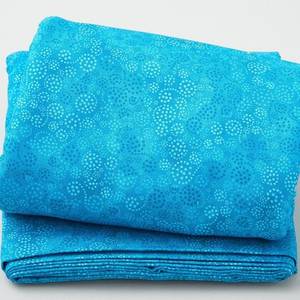

Quilt Backing & Wide Quilt Fabrics
Find the perfect backing for your quilt with our selection of extra wide quilt fabrics. We have quilt backing fabric in a variety of colors and designs! Wide quilt fabric backing is typically up to 108" wide, perfect for covering your entire quilt back without an extra seam. read more




Quilt Backing & Wide Quilt Fabrics

You can be sure that when it comes to backings, we’ve got your … back. We have an impressive selection of both regular quilt backing fabric and wide quilt backings, so there is plenty of variety to choose from no matter the size of your quilt!
Traditional quilting fabric typically comes in widths of around 42-45 inches. However, wide quilt backing fabric is manufactured in wider widths, usually around 108 inches or more. This wider width eliminates the need to piece together multiple sections of fabric to cover the back of a larger quilt, making the process more efficient and reducing the need for seam allowances.
Wide quilt backing fabric comes in a variety of colors, patterns, and materials to complement your quilt top. It allows for a seamless and visually pleasing finish to the back of the quilt. Additionally, the wider width reduces the overall amount of fabric needed for backing, as less yardage is required compared to standard-width fabric. Wide quilt fabric can be particularly beneficial for large quilts or those with intricate designs where piecing together multiple sections of fabric for the backing could detract from the overall aesthetic.
So, what is the best fabric for quilt backing? Well, no backing is necessarily better or worse than the other because it mostly depends on the size of your project. Before you choose your quilt backing material, you need to decide if you want regular quilt backing or wide quilt backing. You might be thinking, “Wait, just how wide is backing fabric for quilts?” Standard fabric generally measures 42” wide and wide quilt backing—also referred to as “extra wides”—measures 108” wide. For smaller projects and quilts not much bigger than a queen size, 42” quilt backing will do just fine! But for bigger quilts (or for the sake of convenience!), it is definitely easier to opt for wide quilt backing because it’s so big you won’t have to do any piecing. But what if you just love a backing so much you’re willing to piece it together? In that case, you’ll want to know how to piece a quilt backing. Let us give you a general rundown!
One important detail to keep in mind is that your quilt backing should always be a bit wider than your quilt top. So, how much wider should quilt backing be? If your quilt is going to be machine quilted, add an extra 8 inches to both the length and width of your quilt. You should do this because it’ll allow some wiggle room for when the machine takes up fabric as it quilts. This trick will also save you from the hassle of your quilt backing fabric turning out to be not wide enough! Then, trim off the selvages and use a 1/2" seam allowance when you’re piecing your quilt backing fabric. Next, sew the pieces together along the longest edge. Pro-tip: Press the seam allowance open to decrease any bulk! Also, it’s best to use horizontal seams for quilts under 60” wide, and vertical seams are best for larger quilts. Here are a few other things to keep in mind: It’s a good idea to choose a quilt backing layout that makes sense for your quilt, and think about the direction of the pattern you’re following. If the print is directional, try to position it so it makes sense with the front of your quilt! If you’re more of a visual learner, we have quilt backing tutorials you can watch, too!
Now you fearless quilters may have questions about quilt backing for king size quilts, like, how many yards of fabric do you need for king size quilt backing. Well, a standard king quilt can vary from 102” x 102” to 107” x 108”, so 108” wide quilt backing would be much more convenient for such a big project. But if you must or want to use standard 42” wide backing, about 9 ⅔ yards of fabric should be just enough. If you do choose to use 108” wide quilt backing, you should only need about 3 to 4 yards. If you want more details about figuring backing, check out our blog about quilt sizes and backing calculation HERE.
Another thing many beginners want to know is what the best material for quilt backing is. As a general rule, it’s best to use the same material as your quilt top. For example, if you used all cotton fabrics for your top, then you may want to opt for a cotton quilt backing as well. Cottons often do prove to be the easiest quilt backing to work with. Of course, you certainly don’t have to use the same material! Quilt backing options are not limited to cotton—you can find standard backing and wide fabric for quilt backing in many different materials! Baby quilts, for instance, are often made with flannel quilt backing fabric, minky, and other soft quilt backing materials a baby would love to snuggle.
Watch the video below to learn how to piece quilt backing on The Final Stitch, a free quilting tutorial with Natalie Earnheart of Missouri Star.
Handy Quilt Backing Resources
Download Pieced Backing Guide PDF ➤
Check out our easy way to calculate how much quilt backing fabric you'll need here.




























































































































































































